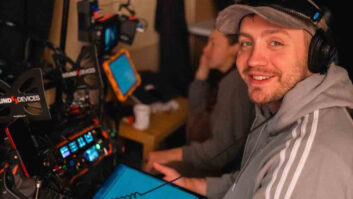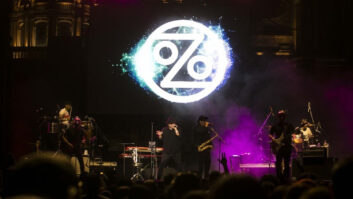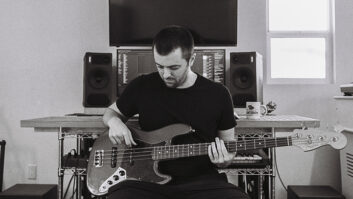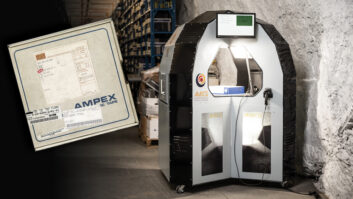
Los Angeles, CA—To help inspire new generations to learn and play music, Foo Fighters’ frontman Dave Grohl recently released Play, a mini-documentary that includes a 23-minute track on which he plays seven different instruments, each recorded in a single take. The instrumental piece was filmed and recorded in Studio One at EastWest Studios in Hollywood over several days in March, with multi-Grammy Award-winning engineer, producer and mixer Darrell Thorp (@darrellthorp) behind the console.
Play, from Roswell Films, an offshoot of Roswell Records, which releases the Foo Fighters’ music, was produced by Grohl and Therapy Content/Therapy Studios. It was directed by Grohl in collaboration with Mark Monroe. The pair previously worked together on the Grammy-winning 2013 documentary Sound City and the Emmy- and Grammy-winning HBO docuseries Sonic Highways.
Grohl’s concept was to film and record each of his parts for the piece, which he wrote in sections on his laptop while touring, in a single, continuous take; one mistake and he started over. “He came in and said, ‘I’ve never played this in its entirety before.’ First he played the drums down, humming the guitar part—and there’s no click,” says Thorp, who also engineered Foo Fighters’ latest album, Concrete and Gold.
The finished piece was built on take four, says Thorp. Next came the first guitar part, bass, then two more guitars, including an acoustic. Percussion and keyboards came last.

Grohl performed the drum part on three kits spread across the studio, with two floor toms placed between, enabling transitions. Play was reportedly also inspired by Grohl watching his own kids, who have appeared on stage with Foo Fighters, learning to play music. Appropriately, the middle kit—labeled “quirky” on the mic input sheet—is a Ludwig set that he borrowed from his pre-teen daughter, Harper. The kit is so tiny that he had to sit on a milk crate to play it, Grohl comments in the video.
Related: Foo Fighters Tour Puts Grohl on Pedestal, by Clive Young, Sep. 21, 2015
Thorp reports, “I was 38 channels wide for the drums, plus a stereo room. I was trying not to be rude and steal every microphone out of the EastWest locker, because they do have two other working rooms. Thankfully, I’m a Lauten Audio artist, so I brought a fair amount of Lauten mics with me.”

Noting that the published mic input list is not entirely accurate, Thorp elaborates, “The Clarion is on kick, my 120s are on overheads, with 220s on the toms, 120s on hi-hats, and an Eden mono overhead on the ‘tight’ kit” on which Grohl starts (and which he played with Them Crooked Vultures). There’s an in-house Neumann U47 FET on the kick drum of the “Bonham” kit on which Grohl ends the piece, Thorp adds. “And I had 421s on toms and 67s on overheads.”
A pair of Cascade Fathead ribbon mics through Compex compressors captured the room. “They’re on the floor, X-Y, on a stereo bar pointed at the Bonham kit and the Vultures kit. A friend texted me and asked how I got the room sound. That’s Dave, dude; he hits so hard. That is not a reverb trigger, that’s the room sound, that’s me just pushing the mics up. I’ve never gotten a room sound like that before.”

Happily, with so many microphones in play simultaneously, EastWest’s Studio One houses an 80-input Neve 8078 that was configured from two smaller consoles. “I used a big chunk of the console,” Thorp says, although he muted almost all but the microphones on the specific drum kit on which Grohl was playing. “I left the two toms between open as ambience; I didn’t want that to sound unnatural.”
Related: Darrell Thorp on Monitor Stands, Sep. 18, 2018
While every mic went through the Neve, Thorp supplemented the signal chain on certain channels. “There was a fair amount of EQ, and I love the midrange and the low end of a Neve, but I love the top air of an API. So in certain situations—and it’s listed on the track sheet—I was using API 550s on the kicks and snares” of all three kits.
“I’ll get some nice air and attack out of the API. Then, for low-mid, I can use the Neve EQ to get really punchy and mid-y. That’s my ‘trick,’ so to speak,” he says.
Thorp says he developed a good working rapport with Foo Fighters tech Samon Rajabnik during the production of Concrete and Gold, which was also recorded in EastWest’s Studio One. “He would get the drums in this really sweet spot,” he recalls.

For the Play sessions, says Thorp, “He was out there playing the kits while I got sounds and levels. I felt I was 80 percent there and thought, once Dave comes in, I’ll dial it in, adjust some levels and we’ll be golden. Dave showed up and he didn’t come in the control room, he just started playing the first kit. I unmute the speakers and listen and … well, I’m done!”
Play was filmed in black and white by director of photography Brandon Trost using 12 roving mini-cameras to capture Grohl performing each of his parts. On the Roswell Films website, Grohl’s individual performances on each instrument are available for viewing and separate music charts may be downloaded. A plan of the live room details the instruments used and their respective positions in the space.
Want more stories like this? Subscribe to our newsletter and get it delivered right to your inbox.
The first part of the mini-doc intercuts behind-the-scenes studio footage with interviews with students from the Join the Band music school in L.A.’s San Fernando Valley. Therapy’s Eddie Kim and Brandon Kim brought together Grohl’s voiceover, the student interviews and the music tracks recorded and mixed by Thorp into the documentary’s final mix.
“It’s awesome to see these kids try to figure it out. I’m still trying to figure it out, still pushing myself, looking for the next challenge, doing something I’ve never done before,” says Grohl’s voiceover. His frustration with not being able to play a 23-minute part without messing up is visible in the first part of the video. But at the end of the day, says Grohl, “The reward is just to play.”
Darrell Thorp • www.darrellthorp.com
Roswell Films • https://play.roswellfilms.com







